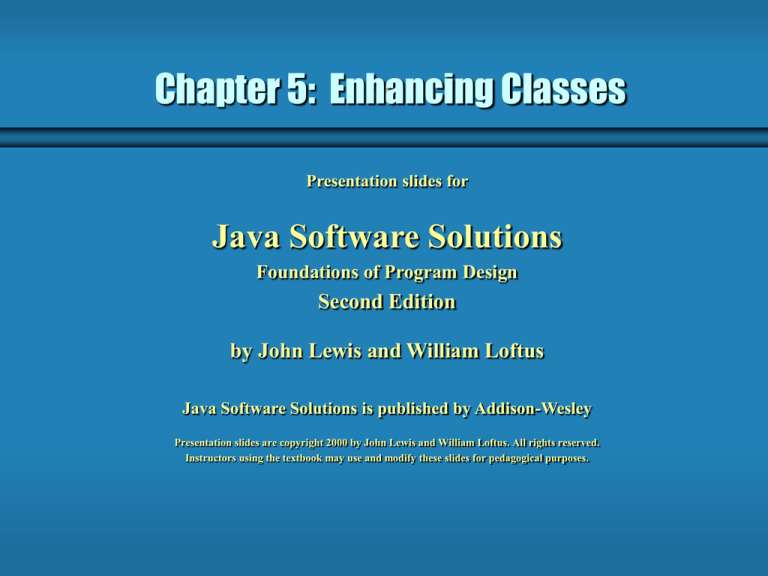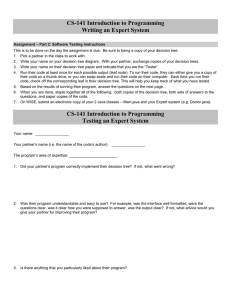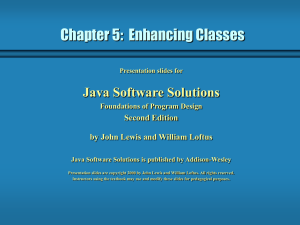
Chapter 5: Enhancing Classes
Presentation slides for
Java Software Solutions
Foundations of Program Design
Second Edition
by John Lewis and William Loftus
Java Software Solutions is published by Addison-Wesley
Presentation slides are copyright 2000 by John Lewis and William Loftus. All rights reserved.
Instructors using the textbook may use and modify these slides for pedagogical purposes.
Enhancing Classes
We can now explore various aspects of classes and objects
in more detail
Chapter 5 focuses on:
•
•
•
•
•
•
•
object references and aliases
passing objects as parameters
the static modifier
nested classes
interfaces and polymorphism
events and listeners
animation
2
References
Recall from Chapter 2 that an object reference holds the
memory address of an object
Rather than dealing with arbitrary addresses, we often
depict a reference graphically as a “pointer” to an object
ChessPiece bishop1 = new ChessPiece();
bishop1
3
Assignment Revisited
The act of assignment takes a copy of a value and stores it
in a variable
For primitive types:
num2 = num1;
Before
After
num1
num2
num1
num2
5
12
5
5
4
Reference Assignment
For object references, assignment copies the memory
location:
bishop2 = bishop1;
Before
bishop1
bishop2
After
bishop1
bishop2
5
Aliases
Two or more references that refer to the same object are
called aliases of each other
One object (and its data) can be accessed using different
variables
Aliases can be useful, but should be managed carefully
Changing the object’s state (its variables) through one
reference changes it for all of its aliases
6
Garbage Collection
When an object no longer has any valid references to it, it
can no longer be accessed by the program
It is useless, and therefore called garbage
Java performs automatic garbage collection periodically,
returning an object's memory to the system for future use
In other languages, the programmer has the responsibility
for performing garbage collection
7
Passing Objects to Methods
Parameters in a Java method are passed by value
This means that a copy of the actual parameter (the value
passed in) is stored into the formal parameter (in the
method header)
Passing parameters is essentially an assignment
When an object is passed to a method, the actual parameter
and the formal parameter become aliases of each other
Passing Objects to Methods
What you do to a parameter inside a method may or may
not have a permanent effect (outside the method)
See ParameterPassing.java (page 226)
See ParameterTester.java (page 228)
See Num.java (page 230)
Note the difference between changing the reference and
changing the object that the reference points to
The static Modifier
In Chapter 2 we discussed static methods (also called class
methods) that can be invoked through the class name
rather than through a particular object
For example, the methods of the Math class are static
To make a method static, we apply the static modifier to
the method definition
The static modifier can be applied to variables as well
It associates a variable or method with the class rather than
an object
10
Static Methods
class Helper
public static int triple (int num)
{
int result;
result = num * 3;
return result;
}
Because it is static, the method could be invoked as:
value = Helper.triple (5);
11
Static Methods
The order of the modifiers can be interchanged, but by
convention visibility modifiers come first
Recall that the main method is static; it is invoked by the
system without creating an object
Static methods cannot reference instance variables, because
instance variables don't exist until an object exists
However, they can reference static variables or local
variables
12
Static Variables
Static variables are sometimes called class variables
Normally, each object has its own data space
If a variable is declared as static, only one copy of the
variable exists
private static float price;
Memory space for a static variable is created as soon as the
class in which it is declared is loaded
13
Static Variables
All objects created from the class share access to the static
variable
Changing the value of a static variable in one object
changes it for all others
Static methods and variables often work together
See CountInstances.java (page 233)
See MyClass.java (page 234)
Nested Classes
In addition to a class containing data and methods, it can
also contain other classes
A class declared within another class is called a nested class
Outer Class
Nested
Class
Nested Classes
A nested class has access to the variables and methods of
the outer class, even if they are declared private
In certain situations this makes the implementation of the
classes easier because they can easily share information
Furthermore, the nested class can be protected by the outer
class from external use
This is a special relationship and should be used with care
Nested Classes
A nested class produces a separate bytecode file
If a nested class called Inside is declared in an outer class
called Outside, two bytecode files will be produced:
Outside.class
Outside$Inside.class
Nested classes can be declared as static, in which case they
cannot refer to instance variables or methods
A nonstatic nested class is called an inner class
Interfaces
A Java interface is a collection of abstract methods and
constants
An abstract method is a method header without a method
body
An abstract method can be declared using the modifier
abstract, but because all methods in an interface are
abstract, it is usually left off
An interface is used to formally define a set of methods that
a class will implement
Interfaces
interface is a reserved word
None of the methods in an
interface are given
a definition (body)
public interface Doable
{
public void doThis();
public int doThat();
public void doThis2 (float value, char ch);
public boolean doTheOther (int num);
}
A semicolon immediately
follows each method header
Interfaces
An interface cannot be instantiated
Methods in an interface have public visibility by default
A class formally implements an interface by
• stating so in the class header
• providing implementations for each abstract method in the
interface
If a class asserts that it implements an interface, it must
define all methods in the interface or the compiler will
produce errors.
Interfaces
public class CanDo implements Doable
{
public void doThis ()
implements is a
{
reserved word
// whatever
}
public void doThat ()
{
// whatever
}
// etc.
}
Each method listed
in Doable is
given a definition
Interfaces
A class that implements an interface can implement other
methods as well
See Speaker.java (page 236)
See Philosopher.java (page 237)
See Dog.java (page 238)
A class can implement multiple interfaces
The interfaces are listed in the implements clause,
separated by commas
The class must implement all methods in all interfaces
listed in the header
Polymorphism via Interfaces
An interface name can be used as the type of an object
reference variable
Doable obj;
The obj reference can be used to point to any object of any
class that implements the Doable interface
The version of doThis that the following line invokes
depends on the type of object that obj is referring to:
obj.doThis();
Polymorphism via Interfaces
That reference is polymorphic, which can be defined as
"having many forms"
That line of code might execute different methods at
different times if the object that obj points to changes
See Talking.java (page 240)
Note that polymorphic references must be resolved at run
time; this is called dynamic binding
Careful use of polymorphic references can lead to elegant,
robust software designs
Interfaces
The Java standard class library contains many interfaces
that are helpful in certain situations
The Comparable interface contains an abstract method
called compareTo, which is used to compare two objects
The String class implements Comparable which gives
us the ability to put strings in alphabetical order
The Iterator interface contains methods that allow the
user to move through a collection of objects easily
Events
An event is an object that represents some activity to which
we may want to respond
For example, we may want our program to perform some
action when the following occurs:
•
•
•
•
•
•
the mouse is moved
a mouse button is clicked
the mouse is dragged
a graphical button is clicked
a keyboard key is pressed
a timer expires
Often events correspond to user actions, but not always
Events
The Java standard class library contains several classes
that represent typical events
Certain objects, such as an applet or a graphical button,
generate (fire) an event when it occurs
Other objects, called listeners, respond to events
We can write listener objects to do whatever we want when
an event occurs
Events and Listeners
Event
Generator
Listener
This object may
generate an event
This object waits for and
responds to an event
When an event occurs, the generator calls
the appropriate method of the listener,
passing an object that describes the event
Listener Interfaces
We can create a listener object by writing a class that
implements a particular listener interface
The Java standard class library contains several interfaces
that correspond to particular event categories
For example, the MouseListener interface contains
methods that correspond to mouse events
After creating the listener, we add the listener to the
component that might generate the event to set up a formal
relationship between the generator and listener
Mouse Events
The following are mouse events:
•
•
•
•
mouse pressed - the mouse button is pressed down
mouse released - the mouse button is released
mouse clicked - the mouse button is pressed and released
mouse entered - the mouse pointer is moved over a particular
component
• mouse exited - the mouse pointer is moved off of a particular
component
Any given program can listen for some, none, or all of these
See Dots.java (page 246)
See DotsMouseListener.java (page 248)
Mouse Motion Events
The following are called mouse motion events:
• mouse moved - the mouse is moved
• mouse dragged - the mouse is moved while the mouse button is held
down
There is a corresponding MouseMotionListener
interface
One class can serve as both a generator and a listener
One class can serve as a listener for multiple event types
See RubberLines.java (page 249)
Key Events
The following are called key events:
• key pressed - a keyboard key is pressed down
• key released - a keyboard key is released
• key typed - a keyboard key is pressed and released
The KeyListener interface handles key events
Listener classes are often implemented as inner classes,
nested within the component that they are listening to
See Direction.java (page 253)
Animations
An animation is a constantly changing series of pictures or
images that create the illusion of movement
We can create animations in Java by changing a picture
slightly over time
The speed of a Java animation is usually controlled by a
Timer object
The Timer class is defined in the javax.swing package
Animations
A Timer object generates an ActionEvent every n
milliseconds (where n is set by the object creator)
The ActionListener interface contains an
actionPerformed method
Whenever the timer expires (generating an ActionEvent)
the animation can be updated
See Rebound.java (page 258)




